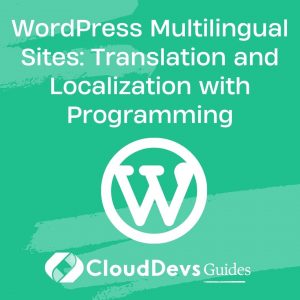WordPress Multilingual Sites: Translation and Localization with Programming
In today’s interconnected world, the digital landscape knows no geographical boundaries. As businesses and content creators strive to reach a global audience, the need for multilingual websites has become more crucial than ever. WordPress, a versatile and widely used content management system, offers a robust platform for building websites, and when combined with the power of programming, it becomes a potent tool for creating multilingual sites that resonate with diverse audiences.
Table of Contents
1. Understanding the Multilingual Imperative
Imagine stumbling upon a website that speaks your language fluently, offering a personalized experience that feels like home. This is the essence of a well-executed multilingual website. It’s not just about translating content word for word; it’s about creating an immersive experience that resonates with the cultural nuances and preferences of different regions. Whether you’re a business owner, blogger, or content creator, the potential to tap into new markets and foster global connections through a multilingual website is immense.
2. Setting the Stage with WordPress
WordPress has proven its prowess as a versatile CMS that can adapt to various needs, and building a multilingual site is no exception. Before delving into the programming aspects, it’s essential to establish a solid foundation using the right tools. The following steps lay the groundwork for your multilingual journey:
2.1. Choose a Translation Plugin: The Heart of Multilingual Functionality
The first step is to select a translation plugin that suits your needs. Plugins like WPML (WordPress Multilingual Plugin) and Polylang are popular choices that seamlessly integrate with WordPress. These plugins enable you to create translations for all aspects of your site, including posts, pages, custom post types, taxonomies, and even themes and plugins. They also provide features like language switchers and URL structures that enhance the user experience.
2.2. Create Language-Specific Content: Tailoring for Global Audiences
Translating content isn’t just about converting words; it’s about adapting the message for cultural relevance. Create language-specific versions of your content, taking into account idioms, cultural references, and local preferences. This step ensures that your website resonates authentically with each target audience.
2.3. Implement SEO Best Practices: Visibility in Every Language
Optimizing your multilingual website for search engines is vital. Each language version should have its own set of meta tags, keywords, and descriptions. Utilize SEO plugins like Yoast SEO to manage language-specific SEO settings effectively. This ensures that your content ranks well in search results for each language, driving targeted traffic to your site.
3. The Power of Programming: Customizing Multilingual Functionality
While translation plugins provide a solid foundation for multilingual websites, there are instances where custom programming is necessary to achieve specific functionalities or address unique requirements. Let’s explore some scenarios where programming comes into play:
3.1. Dynamic Language Switcher: A Seamless User Experience
Implementing a dynamic language switcher allows users to switch between languages effortlessly. This is particularly useful when your site offers content in multiple languages. By using programming languages like JavaScript, you can create a language switcher that updates content on the fly without requiring a page reload. Here’s a sample code snippet using jQuery:
javascript
$('.language-switcher').on('change', function() {
var selectedLanguage = $(this).val();
// Use AJAX to fetch and update content based on the selected language
});
3.2. Language-Specific Styling: Tailored Visuals
Different languages might require specific font styles, alignments, or even layout adjustments. With programming, you can conditionally apply CSS styles based on the selected language. In this example, we’ll use PHP to add a custom CSS class to the body tag, allowing you to apply language-specific styles using CSS:
php
function add_language_body_class($classes) {
$current_language = get_locale();
$classes[] = 'lang-' . $current_language;
return $classes;
}
add_filter('body_class', 'add_language_body_class');
3.3. Language-Dependent Content Ordering: Catering to Regional Preferences
Certain regions might prefer to see content displayed in a specific order. With programming, you can customize the content order based on the selected language. Here’s a simplified code snippet in Python demonstrating how you can reorder a list of content items for different languages:
python
def reorder_content_by_language(content_list, selected_language):
language_order_map = {
'en_US': [1, 2, 3],
'fr_FR': [3, 1, 2],
'es_ES': [2, 3, 1]
}
ordered_content = sorted(content_list, key=lambda item: language_order_map[selected_language].index(item['id']))
return ordered_content
Conclusion
Building and programming multilingual WordPress sites is an art that blends technology, culture, and communication. By harnessing the power of translation plugins and combining it with strategic programming, you can create websites that seamlessly traverse linguistic barriers and foster connections with audiences around the world. Whether you’re a business expanding internationally or a content creator sharing your stories, the ability to speak your audience’s language is a testament to your commitment to global engagement. As technology continues to evolve, so too will the tools at your disposal to create truly impactful multilingual websites that transcend boundaries.
Table of Contents








